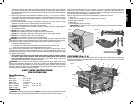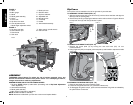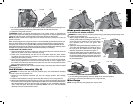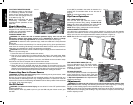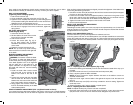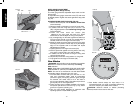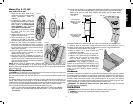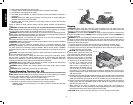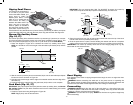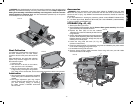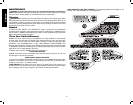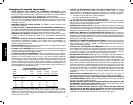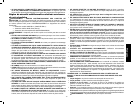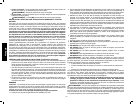
13
English
Ripping Small Pieces
It is unsafe to rip small pieces. It
FIG. 34
U
is not safe to put your hands
close to the blade. Instead, rip a
larger piece to obtain the
desired piece. When a small
width is to be ripped and the
hand cannot be safely put
between the blade and the rip
fence, use one or more push
sticks. A pattern is included at
the end of this manual to make
push sticks. A push stick (U) is
included with this saw, attached to the rip fence. Use the push stick(s) to hold the work piece
against the table and fence, and push the work piece fully past the blade. See Figure 34.
Narrow Rip Auxiliary Fence
(Fig. 35, 37)
The narrow rip auxiliary fence should be used for a rip measuring 2" (50.8 mm) or narrower.
This fence will allow the guard to remain on the saw when completing narrow ripping. This
fence will provide ample space for proper use of a push block (A12, see Push Block).
1. Follow the diagram in Figure 35 to construct the narrow rip auxiliary fence (A13).
NOTE: A11 should be cut to fit the length of the saw table top and sides (A14) must be
parallel.
3/8"
(9.5 mm)
1"
(25 mm)
1/2"
(12.7 mm)
FIG. 35
A14
A11
4-3/4"
(121 mm)
3/8"
(9.5 mm)
2. After the narrow rip auxiliary fence is constructed, slip it over the saw table top and place
it flush to the fence as shown in Figure 37.
3. Feed the work piece through until the edge of the material reaches the front edge of the
saw table top.
4. Continue feeding the material using the push block (A12) until the cut is complete.
Push Block (Fig. 36, 37)
IMPORTANT: Only use the push block (A12) with the narrow rip auxiliary fence, see Narrow
Rip auxiliary Fence. The push block should be used once the material being cut reaches
the saw table top.
1. Construct a push block using the diagram in Figure 36.
NOTE: Edges (A15) must be the same size.
IMPORTANT: The over hanging edge (A16, Fig. 36) MUST be square. An uneven lip
could cause the push block to slip or push the material away from the fence.
12
"
(305 mm)
A12
A15
FIG. 36
A16
2-1/2" (64 mm)
5"
(127 mm)
1/2"
(12.7 mm)
4-3/4"
(121 mm)
12"
(305 mm)
1/2"
(12.7 mm)
5-1/4"
(133 mm)
2-1/2"
(64 mm)
1/2"
(12.7 mm)
2. Place the push block (A12, Fig. 37) behind the material and ensure the lip of the block
is flush to the narrow rip auxiliary fence (A13).
3. Once the push block is in place, continue feeding the material until the cut is complete
making sure the push block remains flush to the narrow rip auxiliary fence at all times.
IMPORTANT: The narrow rip auxiliary fence and the over hanging edge (A16, Fig. 36)
should both be the same thickness.
FIG. 37
A12
A13
Bevel Ripping
This operation is the same as ripping except the bevel angle is set to an angle other than
zero degrees.
WARNING: Before connecting the table saw to the power source or operating the
saw, always inspect the blade guard assembly and riving knife for proper alignment and
clearance with saw blade. Check alignment after each change of bevel angle.
Crosscutting
WARNING: NEVER touch the “free end” of the work piece or a “free piece” that is cut
off, while the power is ON and/or the saw blade is rotating. Piece may contact the blade
resulting in a thrown work piece and possible injury.
WARNING: To reduce the risk of injury, NEVER use the fence as a guide or length stop
when crosscutting.



